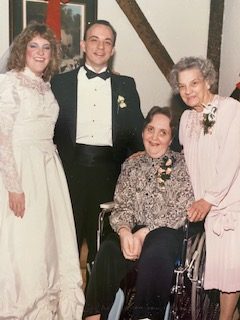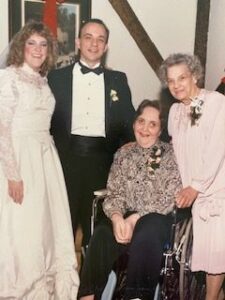When I married my husband John in 1987, I said “I do” to three people: John, his mother Sophie, and his sister Laurie. John was the caregiver, household manager, driver, and grocery purveyor for his mother, who had several health issues at the age of 68, and his younger sister, who was born with Marfan Syndrome, a disorder of the connective tissue resulting in a host of physical challenges. Laurie also experienced oxygen deprivation at birth. As a result, she never cognitively developed past the age of 7 or 8.
Neither Laurie or Sophie are with us today, but in honor of National Special Education Day, I want to elevate Laurie’s education story, however fragmented it was. Laurie was provided transportation to an elementary school building starting in kindergarten, but there was no grade designation, no Individualized Education Program (IEP), and no social supports. She learned some very rudimentary skills, like how to count from 1 to 10 and write her first name. We know very little of what she experienced at school, but my husband remembers the taunts of “retard” thrown her way by neighborhood and school bullies. By middle school, she no longer attended school.
Like most parents, neither Sophie nor her husband were prepared for a child with special needs. Sophie was very private, but I gathered a few pieces of her story over the years we lived together. A child of Polish immigrants, Sophie’s education didn’t advance much past middle school. During the Great Depression, kids did whatever they could to keep their families from starving, and while she shared very few Depression-era memories, standing in bread lines was often her job. I regret not knowing her full story — she held many secrets — but the best we could cobble together was that her teen years were akin to sooty Cinderella, providing domestic labor until she met her real-life prince in the form of John’s father, the appliance repairman she married.
The fact that they advocated for any schooling, including transportation services, for Laurie is a tribute to the doggedness of their own backgrounds. The gaps in Laurie’s education were representative of that era, and I am glad we have moved to a point where we recognize National Special Education Day and the importance of serving all students.
People often tell me how much they admire what John and I did, caring for Laurie and Sophie in our home as we raised our own family. But Sophie deserves the credit for standing up for her daughter in an era when mothers were shamed for having a special needs child. And Laurie faced many of her physical and cognitive challenges as an adult: She eventually learned to read with Hooked on Phonics, and learned to laugh again, thanks to the antics of her two nieces and one nephew.
So much has improved in the special education field since Laurie’s experience in the 1960s, but there is still more to be done. These experiences tie me closely to Bellwether’s mission, and remind me of our commitment to improving education and life outcomes for underserved students, including those in special education.

